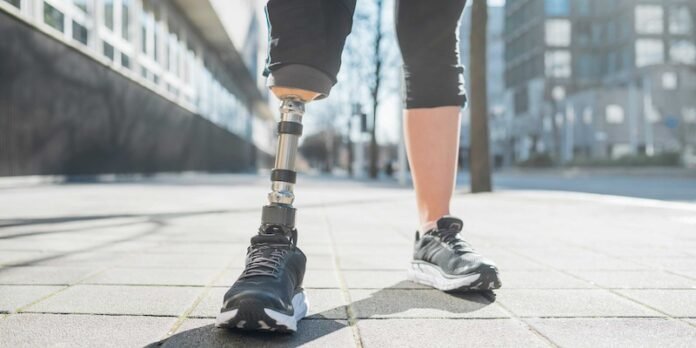Prostheses that connect with the nervous system have been obtainable for a number of years. Now, researchers at ETH Zurich have discovered proof that neuroprosthetics work higher once they use indicators which might be impressed by nature.
Just a few years in the past, a workforce of researchers working underneath Professor Stanisa Raspopovic on the ETH Zurich Neuroengineering Lab gained worldwide consideration once they introduced that their prosthetic legs had enabled amputees to really feel sensations from this synthetic physique half for the primary time.
Not like business leg prostheses, which merely present amputees with stability and help, the ETH researchers’ prosthetic system was related to the sciatic nerve within the take a look at topics’ thigh through implanted electrodes.
This electrical connection enabled the neuroprosthesis to speak with the affected person’s mind, for instance relaying data on the fixed adjustments in strain detected on the only of the prosthetic foot when strolling.
This gave the take a look at topics higher confidence of their prosthesis – and it enabled them to stroll significantly quicker on difficult terrains.
“Our experimental leg prosthesis succeeded in evoking pure sensations. That’s one thing present neuroprostheses are primarily unable to do; as a substitute, they largely evoke synthetic, disagreeable sensations,” Raspopovic says.
That is in all probability as a result of right this moment’s neuroprosthetics are utilizing time-constant electrical pulses to stimulate the nervous system.
“That’s not solely unnatural, but additionally inefficient,” Raspopovic says. In a just lately printed paper, he and his workforce used the instance of their leg prostheses to spotlight the advantages of utilizing naturally impressed, biomimetic stimulation to develop the following technology of neuroprosthetics.
Mannequin simulates activation of nerves within the sole
To generate these biomimetic indicators, Natalija Katic – a doctoral pupil in Raspopovic’s analysis group – developed a pc mannequin known as FootSim.
It’s primarily based on knowledge collected by collaborators in Canada, who recorded the exercise of pure receptors, named mechanoreceptors, within the sole of the foot whereas touching completely different factors on the ft of volunteers with a vibrating rod.
The mannequin simulates the dynamic behaviour of huge numbers of mechanoreceptors within the sole of the foot and generates the neural indicators that shoot up the nerves within the leg in direction of the mind – from the second the heel strikes the bottom and the burden of the physique begins to shift ahead to the skin of the foot till the toes push off the bottom prepared for the following step.
“Due to this mannequin, we will see how semsory receptors from the only, and the related nerves, behave throughout strolling or working, which is experimentally not possible to measure” Katic says.
Data overload within the spinal twine
To evaluate how carefully the biomimetic indicators calculated by the mannequin correspond to the indicators emitted by actual neurons, Giacomo Valle – a postdoc in Raspopovic’s analysis group – labored with colleagues in Germany, Serbia and Russia on experiments with cats, whose nervous system processes motion in an identical option to that of people.
The experiments passed off in 2019 on the Pavlov Institute of Physiology in St. Petersburg and have been carried out in accordance with the related European Union tips.
The researchers implanted electrodes, connecting some to the nerve within the leg and a few to the spinal twine to find how the indicators are transmitted via the nervous system.
When the researchers utilized strain to the underside of the cat’s paw, thereby evoking the pure neural response that happens when a cat takes a step, the peculiar sample of exercise recorded within the spinal twine did certainly resemble the patterns that have been elicited within the spinal twine when the researchers stimulated the leg nerve with biomimetic indicators.
In contrast, the standard method of time-constant stimulation of the sciatic nerve within the cat’s thigh elicited a markedly completely different sample of activation within the spinal twine.
“This clearly exhibits that the generally used stimulation strategies trigger the neural networks within the backbone to be flooded with data,” Valle says.
“This data overload could possibly be the rationale for the disagreeable sensations or paraesthesia reported by some customers of neuroprosthetics,” Raspopovic provides.
Studying the language of the nervous system
Of their medical trial with leg amputees, the researchers have been in a position to present that biomimetic stimulation is superior to time-constant stimulation.
Their work clearly demonstrated how the indicators that mimicked nature produced higher outcomes: not solely have been the take a look at topics in a position to climb steps quicker, in addition they made fewer errors in a job that required them to climb the identical steps whereas spelling phrases backwards.
“Biomimetic neurostimulation permits topics to focus on different issues whereas strolling,” Raspopovic says, “so we concluded that the sort of stimulation is extra naturally processed and fewer taxing on the mind.”
Raspopovic, whose lab kinds a part of the ETH Institute of Robotics and Clever Methods, believes that these new findings usually are not solely related to the limb prostheses he and his workforce have been engaged on for over half a decade.
He argues that the necessity to transfer away from unnatural, time-constant stimulation in direction of biomimetic indicators additionally applies to an entire sequence of different aids and units, together with spinal implants and electrodes for mind stimulation.
“We have to study the language of the nervous system,” Raspopovic says. “Then we’ll have the ability to talk with the mind in methods it actually understands.”
Reference: Valle G, Katic Secerovic N, Eggemann D, Gorskii O, Pavlova N, Petrini FM, Cvancara P, Stieglitz T, Musienko P, Bumbasirevic M, Raspopovic S: Biomimetic computer-to-brain communication enhancing naturalistic contact sensations through peripheral nerve stimulation. Nature Communications, 20 February 2024, doi: 10.1038/s41467-024-45190-6
